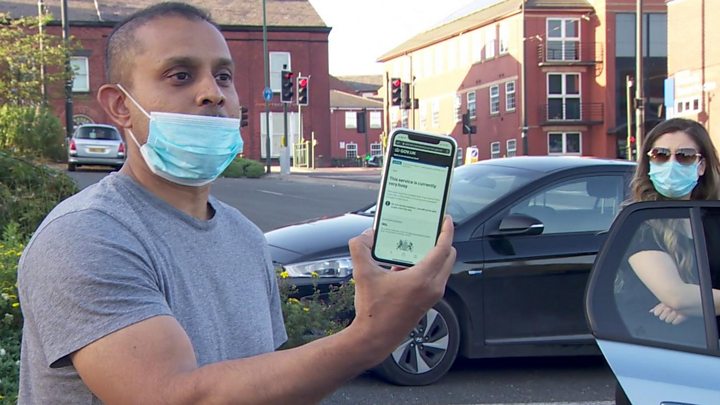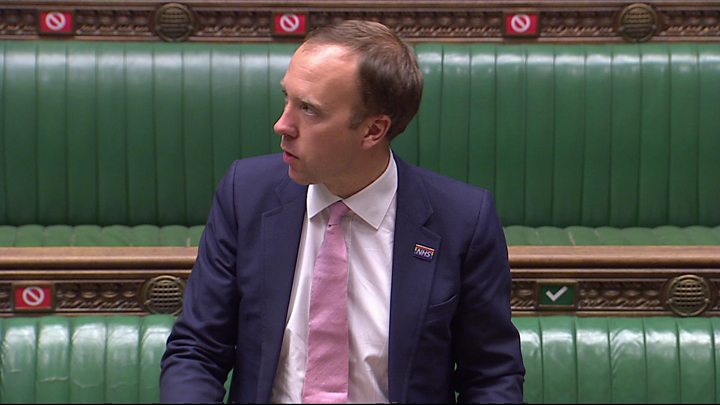 Image copyright
HoC
Image copyright
HoC
The testing system is facing an "enormous challenge" after a "sharp rise" in those seeking a Covid-19 test, Health Secretary Matt Hancock has said.
When challenged on reports of people struggling to get swabbed, Mr Hancock said it would take a "matter of weeks" to resolve the problems.
He said No 10 would update its testing policy shortly to prioritise the most urgent cases.
Labour said no tests were available in virus "hotspots" over the weekend.
It comes after hospital bosses warned that a lack of tests for NHS workers was putting services at risk.
An increase in demand for coronavirus tests has led to local shortages, with some people being directed to test sites hundreds of miles from their homes.
People have told the BBC of their frustration at being turned away from a walk-in test centre in Oldham, Greater Manchester.
A woman attending the walk-in centre said staff told her that labs were struggling to turn tests around.
One parent questioned whether he would have to keep his child - who has a high temperature and a cough - off school indefinitely until they could get a test.
Another parent, who suffers from chronic obstructive pulmonary disease (COPD) and lung problems, said he was "really concerned" about the testing problems after his daughter was sent home from school due to a classmate contracting the virus.

Media playback is unsupported on your device
On Saturday, Cabinet Office minister Michael Gove told the BBC that the government was working to boost testing capacity through investment in new testing centres and so-called lighthouse labs.
Scotland's First Minister Nicola Sturgeon has said she is hopeful that a backlog in test results will be resolved shortly, after "constructive" talks with Mr Hancock.
The UK government announced 3,105 new lab-confirmed cases on Tuesday, bringing the total number of positive tests to 374,228. Another 27 people have died within 28 days of a positive coronavirus test, bringing the overall death toll to 41,664.
The number of patients in mechanical ventilation beds across the UK has passed 100 for the first time in nearly two months. There were 106 patients on ventilation in the UK on Monday - the first time the figure has been over 100 since 24 July.
UK-wide figures for today are yet to be published but there were 101 patients on ventilation in England alone on Tuesday.
Around 220,000 tests are processed each day, according to government figures released last week, with a testing capacity of more than 350,000 - which includes swab tests and antibody tests. The aim is to increase that to 500,000 a day by the end of October.
Speaking in the House of Commons, Mr Hancock said there were "operational challenges" with testing which the government was "working hard" to fix.
He said throughout the pandemic they had prioritised testing according to need.
Mr Hancock said the "top priority is and always has been acute clinical care", followed by social care, where the government is sending "over 100,000 tests a day" due to the virus risks in care homes.

Media playback is unsupported on your device
Conservative chairman of the Health and Social Care Committee Jeremy Hunt was among the MPs to question Mr Hancock on testing, saying a number of his constituents had to travel for tests, while one key worker had to wait a week for her results.
"A week ago today, the secretary of state told the Health Select Committee that he expected to have this problem solved in two weeks," Mr Hunt said.
"Is the secretary of state, given the efforts that his department is making, still confident that in a week's time we will have this problem solved?"
"I think that we will be able to solve this problem in a matter of weeks," Mr Hancock replied.
He said demand was "high" but "record capacity" was being delivered, with plans to ensure tests are prioritised for those that need them most.
Despite the health secretary's promises, there will be no easy solution to the shortages of tests.
All the expectations are that cases will go up. People are circulating more as society reopens and we are entering the period when respiratory viruses thrive.
As cases go up so will demands on the testing system. Even with the promise of more testing capacity in the coming weeks, the chances of shortages continuing remains a distinct possibility.
A new lab is due to open later this month which will be able to carry out 50,000 tests a day. But this could easily be swallowed up.
What it means is that testing will have to be prioritised where it is needed most. That will be in care homes, hospitals and among key workers, as well as where there are local outbreaks. The government's surveillance programme run by the Office for National Statistics will also be protected.
But this is not unique to the UK. Other countries are facing similar pressures. In fact, the UK is testing more people per head of population than Spain, France and Germany.
It promises to be a difficult winter across Europe.
'Enormous challenge'
Labour's shadow health secretary Jonathan Ashworth said Mr Hancock was "losing control of this virus".
He said that after schools and offices reopened, extra demand on the system was "inevitable". He questioned why Mr Hancock did not use the summer "to significantly expand" NHS lab capacity and "fix" contact tracing.
Responding, Mr Hancock said it was "inevitable" that demand would rise with a free service, adding the "challenge" was to ensure tests are prioritised for those who most need them.
What's the average journey to a Covid-19 test centre?
By Ben Butcher, BBC Reality Check
Health Secretary Matt Hancock claims that the average distance travelled by people to a test centre is 5.8 miles.
Last week, he used a slightly different figure - 6.4 miles.
So, is this right? The problem is they're not releasing the data on journey times - despite us asking for it repeatedly.
The Department of Health says it plans to "at some point in the future". This makes it very difficult to scrutinise the claims.
It has supplied a limited amount of information about the methodology.
The average distance refers to "as the crow flies", so it doesn't take into account that most roads are not a straight line between someone's house and the testing site. This means the average distance will be higher.
For example, if someone was to drive between the BBC London offices and the Wembley testing site, the exact distance between the two is 5.5 miles. However, once we take into account roads, this increases to around 8 miles.
Additionally, Mr Hancock previously said 90% of people travel less than 22 miles, meaning 10% travelled further.
In the latest week, 199,000 tests were processed from regional testing facilities, meaning as many as 20,000 people travelled over 22 miles.
We also don't know how many people asked for a testing slot but chose not to travel because the site they were offered was too far away.
Earlier, Home Secretary Priti Patel told BBC Breakfast the government was "surging capacity" where it was needed.
She said there is "much more work" to be done with Public Health England (PHE) and local public health bodies; and that No 10 would continue to work with PHE to "surge where there is demand" in hotspots.
Ms Patel also said England's new rule of six meant families should not stop in the street to talk to friends.

 5 years ago
630
5 years ago
630 

